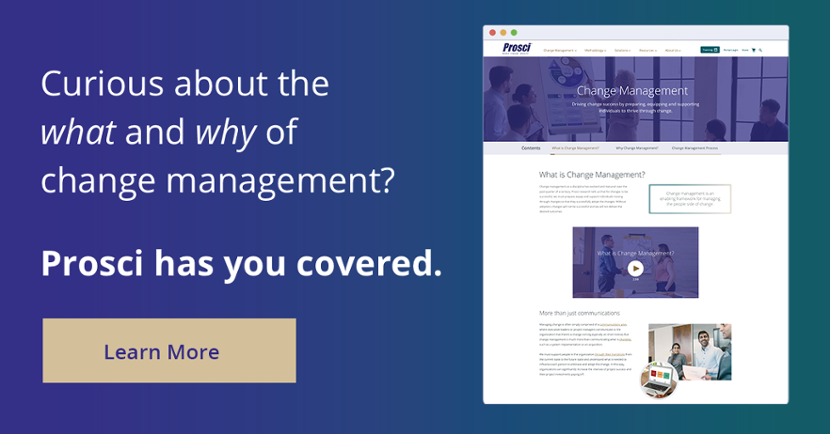6 Questions About Change Management Methodologies

4 Mins
Updated: March 18, 2024
Published: April 3, 2019

Over the past 25 years, the use of structured methodologies for managing the people side of change has increased dramatically. Below are the most frequently asked questions we receive about change management methodologies, including the Prosci Methodology.
What is the value of
using a methodology to manage change?
A methodology for change management provides structure and intent for managing the people side of change. Change in organizations is a reality, as is the fact that these changes ultimately impact how individual employees do their jobs. Given that the success of an organizational effort is tied inextricably to individuals adopting the change, change management provides tools and processes for encouraging and enabling those individual changes. The advantages of using a structured methodology include:
- Provides structure and rigor for the people side of change
- Enables repeatability
- Addresses all of the key components
- Avoids missing important steps
- Draws on the lessons learned by others
An important point here: A methodology for change management doesn't define or prescribe particular changes. Change management doesn't tell you what changes your organization needs to make. Change management is an overlay—it is applied to changes that are already identified to encourage employees to adopt and utilize those changes.
Can I manage the people side of change
without a methodology? What are the risks?
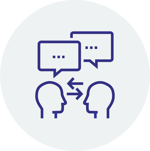 Certainly, you could introduce a change without using a methodology or addressing the people side of change. Most projects, regardless of whether they are using change management, will have some elements of a communication plan and a training plan.
Certainly, you could introduce a change without using a methodology or addressing the people side of change. Most projects, regardless of whether they are using change management, will have some elements of a communication plan and a training plan.
The problem is that these communication plans tend to be "telling plans" full of project updates and details, instead of what employees really want to know—namely, why the change is happening and "what's in it for me" (WIIFM). Likewise, training plans in the absence of a change management framework typically do not have the necessary context and foundation to be effective. In particular, they need a compelling case for why the change is happening and why someone should be engaged. Have you ever been sent to training without understanding why it was important to be there? It feels like a waste of time and can actually demotivate you.
The risks of trying to manage change without a structured approach include:
- Not providing the necessary context for your activities
- Not focusing your actions based on where employees are in the change process
- Missing key steps or activities
- Attempting to manage the change without all of the right "actors" involved (i.e., senior leaders as sponsors of change, and people managers coaching the people on their teams through the change)
- Wasting time and energy by "reinventing the wheel"
Some very experienced and expert practitioners may be able to address a change initiative without a structured methodology in place. But the majority of practitioners benefit from having a structured process and set of tools to guide activities. Even experienced practitioners can benefit from these guidelines.
Does following a methodology make
change management into a set of "boxes to check"?
 Absolutely not. The foundation of a solid change management methodology is that individuals are the ones who adopt a change. Change is organic and fluid, and it is a very personal experience. However, we can model it and take actions to encourage and support it. Just because we are applying a methodology—following a process and utilizing tools and templates—doesn't mean we are removing people from the equation. Instead, we are drawing upon research and the experience of others to put ourselves in the best position to succeed.
Absolutely not. The foundation of a solid change management methodology is that individuals are the ones who adopt a change. Change is organic and fluid, and it is a very personal experience. However, we can model it and take actions to encourage and support it. Just because we are applying a methodology—following a process and utilizing tools and templates—doesn't mean we are removing people from the equation. Instead, we are drawing upon research and the experience of others to put ourselves in the best position to succeed.
Is designing the solution part of a
change management methodology?
From our perspective, defining the solution is not part of the change management methodology. Change management, like project management, is a discipline and set of tools applied to a particular change. This means that recognizing a need for change and developing a solution take place in a parallel but different workstream. Prosci's Unified Value Proposition shows the distinct workstreams that support successful change and transformation in an organization.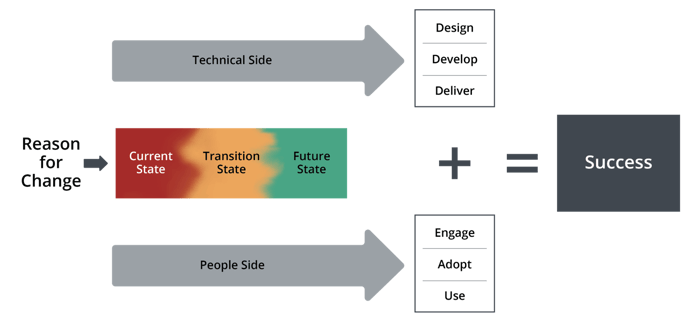
What do other practitioners look for when selecting a methodology?
Participants in Prosci's Best Practices in Change Management benchmarking research identified the key factors for selecting the methodology they used on their projects. The top factors they cited include:
1. Previous experience or external advice
Many participants cited their personal experience with a particular methodology as a key factor in selection, as well as advice from external consultants and a methodology's status as an industry standard.
2. Credibility
Methodologies that were well-known and based on a clear, structured and tested approach were favored over newer methodologies.
3. Compatibility with the project, company, culture or industry
Participants reported that they were likely to select a methodology if it was especially compatible with an ongoing project or the culture of the industry. They sought a methodology that aligned with the needs of the organization, the needs of the project, or budgetary requirements.
4. Easy to use and scalable
Participants favored a methodology that was easy to use and could be scaled to meet the change being managed. Additional characteristics in this category included:
- Simple
- Easy to implement
- Easy to communicate to others
- Practical
- Structured and systematic
- Comprehensive and holistic
- Flexible
5. Certified or trained in the methodology
Participants were more likely to select a methodology if resources within the organization were already trained or certified in that methodology. The degree of familiarity and amount of previous success with the model by practitioners also contributed to the confidence expressed toward the methodology.
Practitioners are looking for methodologies that are credible and easy to use. Managing the people side of change is challenging. Although it is sometimes called the "soft" side of change, getting employees to adopt a new process, technology or other new ways of working is often the "harder" side of change.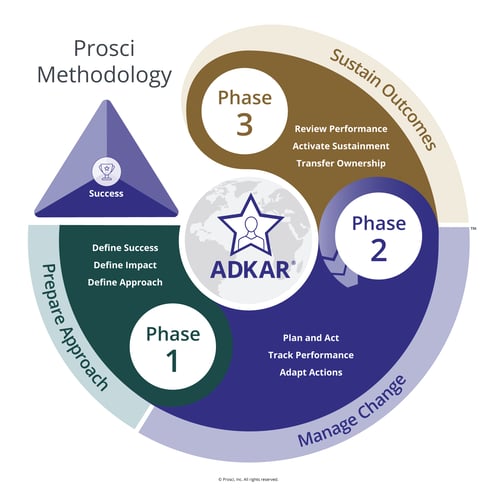
The technical side of change can be complex, but changing employee behaviors is the bigger challenge. This is why practitioners are looking for simple, actionable approaches that deliver results—a methodology that makes sense and can be scaled to meet the particular change at hand without overly complicating the issue.
What is meant by individual change management
and organizational change management?
The Prosci Methodology is founded on the principle that effective change management requires two perspectives: an individual perspective and an organizational perspective. It is the marriage of individual change management and organizational change management that provides an outcome orientation with the supporting tools and processes to make a change successful.
Individual change management is an understanding of and model for how one person successfully makes a change. The Prosci ADKAR Model describes the five building blocks of successful individual change: Awareness, Desire, Knowledge, Ability and Reinforcement. This results-oriented model can also be scaled to guide change management plans, measure progress, and diagnose gaps.
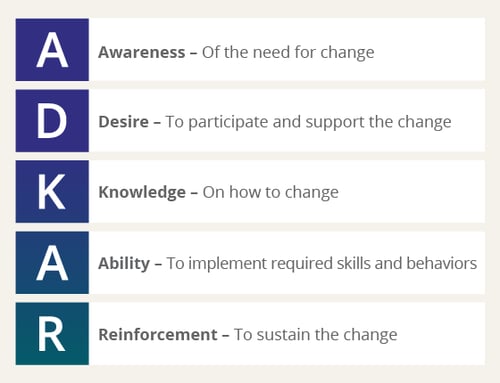 Organizational change management, on the other hand, answers the question: "What am I going to do to support individuals through change at scale?" Organizational change management is applied by change management practitioners, project leaders, and project team members, with the employee-facing actions executed by senior leaders, managers and supervisors throughout the organization. Prosci's organizational change management process—or the Prosci 3-Phase Process—comprises three phases for practitioners to work through:
Organizational change management, on the other hand, answers the question: "What am I going to do to support individuals through change at scale?" Organizational change management is applied by change management practitioners, project leaders, and project team members, with the employee-facing actions executed by senior leaders, managers and supervisors throughout the organization. Prosci's organizational change management process—or the Prosci 3-Phase Process—comprises three phases for practitioners to work through:

Each phase includes activities and tools to support change management application by practitioners. By following the organizational change management process, you create a strategy and full set of plans to move the employees impacted by a change through their own change journey.
For a deeper discussion of the Prosci Methodology, visit our Resource Center, where you will find in-depth articles about the Prosci Methodology, Prosci 3-Phase Process, ADKAR Model, integrating change management and project management, and roles in change management.
